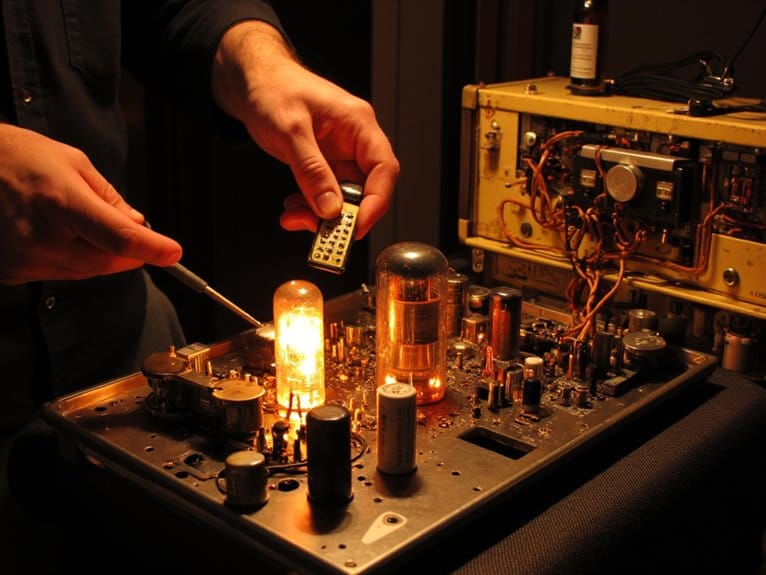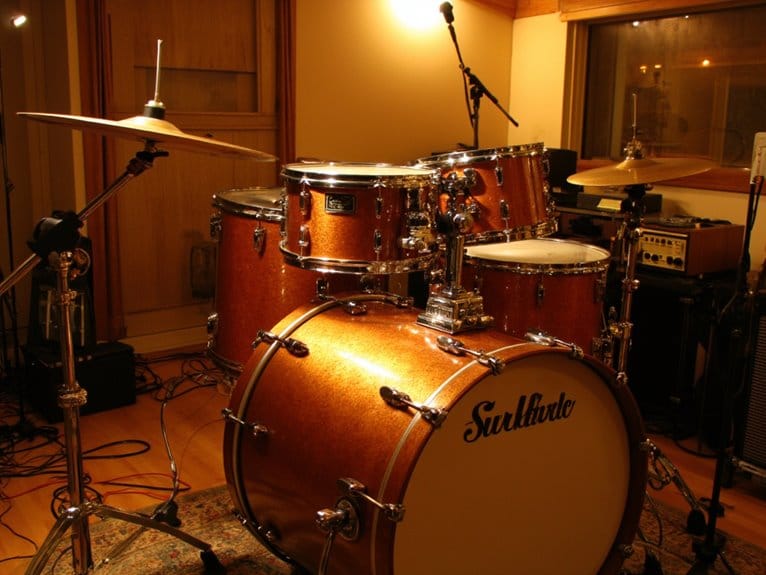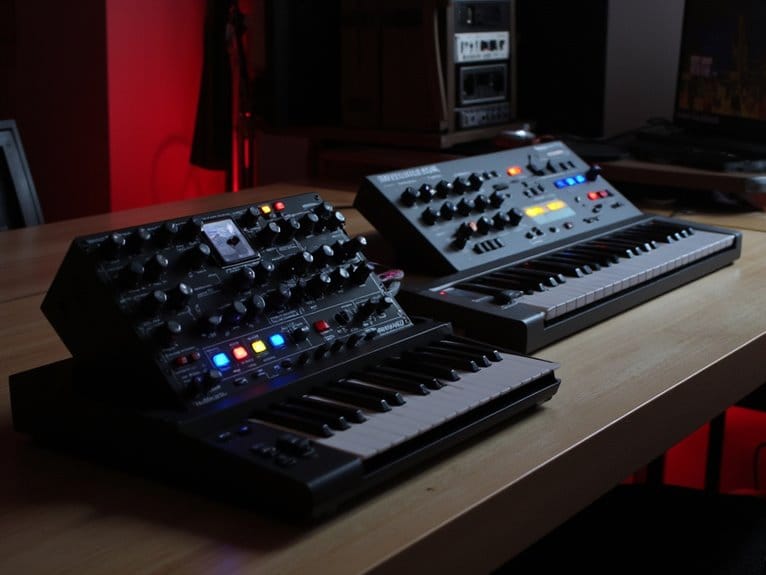Troubleshooting Common Tube Guitar Amplifier Issues
When your tube amp starts crackling, dropping volume, or shutting down unexpectedly, you’re likely dealing with faulty tubes, signal path issues, or power supply problems that represent about 60% of amplifier malfunctions. Start by visually inspecting tubes for discolored or cracked glass, then perform a tap test to identify specific problem tubes, while checking socket connections and coupling capacitors for continuity issues that cause intermittent sound problems. Understanding these diagnostic techniques will help you tackle more complex troubleshooting scenarios.
We are supported by our audience. When you purchase through links on our site, we may earn an affiliate commission, at no extra cost for you. Learn more.
Notable Insights
- Identify faulty tubes by checking for crackling noises, volume drops, discolored glass, and performing tap tests during operation.
- Test signal path with 700 Hz sine wave generator and oscilloscope to locate approximately 60% of amplifier malfunctions.
- Diagnose power supply problems using variac and wattmeter while checking rectifier tubes and filter capacitor operation under load.
- Clean oxidized tube socket contacts with DeoxIT cleaner every six months to prevent crackling and performance dropouts.
- Seek professional service for filter capacitor replacements, output transformer failures, or symptoms like burnt smells and brown spots.
Identifying and Replacing Faulty Tubes
When your tube amp starts acting up, you’ll want to know exactly what’s going wrong before you start pulling tubes and spending money on replacements. Identifying symptoms becomes straightforward once you recognize the telltale signs: crackling noises, sudden volume drops, intermittent sound cutouts, or complete amp shutdown that screams tube failure. In addition to these symptoms, you may notice a loss of warmth or depth in your sound, which can be particularly disheartening for fans of classic tone tube amplifiers. Regular maintenance can help prevent such failures and ensure that you continue to enjoy the rich, dynamic sound that tube amps are known for. Paying attention to these signs can save you time and money, allowing you to keep your amp in optimal condition.
Visual inspection reveals discolored, cloudy, or cracked glass indicating it’s time for surgery. If noise disappears after your amp warms up, you’re likely dealing with weak tubes on their last legs. A simple tap test can help pinpoint which specific valve is causing problems by listening for changes in sound when gently tapping each tube.
Before installing replacements, matching specifications becomes critical—consult your amp’s manual for exact tube types, electrical parameters, and manufacturer recommendations. Quality tubes from reputable brands prevent premature failures and maintain consistent tone across your rig’s performance range. Just like with audio interfaces, ensuring proper phantom power settings before connecting any equipment minimizes unwanted noise and protects your gear. Immediate replacement can prevent transformer damage to other critical components in your amplifier.
Testing Signal Path and Connectivity Components
Most troubleshooting efforts I’ve conducted over the years reveal that signal path problems account for roughly 60% of amplifier malfunctions, making systematic testing your most reliable diagnostic approach.
You’ll want to start with an audio generator producing a 700 Hz sine wave at 150-200 millivolts, connecting a 4.7-ohm dummy load to prevent speaker damage during testing.
Begin at the input jack and trace sequentially through each gain stage, monitoring signal integrity with an oscilloscope or signal tracer.
Check tube socket pins, particularly pin 2 for input and pin 1 for plate output on 12AX7s, while maintaining waveform monitoring throughout.
Inspect coupling capacitors, pot connections, and switches for continuity issues that commonly disrupt signal flow.
Diagnosing Power Supply and Transformer Problems
Once you’ve verified the signal path integrity, power supply malfunctions become the next logical suspect in your diagnostic hierarchy, and I’ve found these issues can masquerade as problems elsewhere in the circuit. Your first step involves using a variac and wattmeter to gradually power up the amplifier while monitoring current draw, since abnormal increases indicate transformer faults that could lead to thermal issues.
I always check secondary voltage output under load conditions with a multimeter to detect voltage drops affecting voltage stability. Test your rectifier tubes and solid-state diodes for proper operation, then inspect filter capacitors for bulging or leakage causing ripple voltage.
Don’t forget to verify that your output transformer rating matches tube specifications to prevent overheating. When dealing with power supply problems, ensure adequate ventilation around the chassis for proper heat dissipation, as tube amplifiers generate significant thermal energy that can affect component longevity and performance.
Maintaining Sockets and Contact Points
Oxidation and corrosion represent the silent killers of tube socket performance, and I’ve seen more amplifiers plagued by poor contact issues than almost any other single problem in my years of repair work.
Socket cleanliness becomes critical when you’re chasing intermittent crackling or mysterious signal dropouts that drive guitarists absolutely mad. I recommend using DeoxIT contact cleaner with small brushes or pipe cleaners, working gently around each contact while the amp’s unplugged and capacitors have discharged for safety.
Those maddening crackles and dropouts that haunt guitarists usually trace back to dirty, oxidized tube socket contacts requiring careful cleaning.
Contact tension adjustment requires careful work with a small flathead screwdriver, gently pushing spring contacts closer together to restore proper tube pin grip.
Regular maintenance every six to twelve months prevents most socket-related headaches before they start affecting your tone.
Recognizing When Professional Service Is Required
How do you know when that frustrating amp problem has crossed the line from DIY territory into professional repair zone?
When you’re facing filter capacitor replacements, output transformer failures, or complex circuit board component issues, it’s time to step back and consider repair costs versus potential damage from amateur attempts.
I’ve learned that microphonic preamp tubes, power supply faults with blown fuses, and moisture damage to internal contacts require technician qualifications that most of us simply don’t possess.
Signs like brown spots on tubes, burnt smells, complete sound loss, or intermittent power cycles indicate serious problems where the high voltage risks, specialized diagnostic tools, and precise component matching demands make professional service not just recommended, but essential for safety.
Frequently Asked Questions
How Often Should I Replace Tubes in My Amp for Optimal Performance?
You should replace power tubes every 1-2 years for ideal tube lifespan, while preamp tubes last much longer. Regular maintenance like bias checks and sound evaluations helps determine when replacement’s actually needed.
Can I Mix Different Tube Brands in the Same Amplifier?
You can safely mix different tube brands in your amplifier as long as they’re the same tube type. Tube compatibility isn’t affected by brand mixing, but you’ll need proper biasing and matching for peak performance.
What Causes My Amp to Sound Muddy or Lose Clarity Over Time?
Your amp’s tone clarity degrades as tubes wear out from heat and usage, affecting frequency response. Dirty connections, failing capacitors, and oxidized tube pins also contribute to muddy sound by reducing signal transmission and dulling high frequencies.
Why Does My Amp Sound Different After Warming up for Several Minutes?
Your amp’s tone change after warming up happens because tube performance improves as they reach ideal operating temperature. Cold tubes sound muddy, but warm tubes deliver richer, more open sound with better stability and natural compression.
On a final note
You’ll find that most tube amp problems stem from worn tubes, loose connections, or aging capacitors, and while I’ve covered the fundamentals here, don’t hesitate to tackle simple fixes like tube swapping or socket cleaning yourself. However, when you’re dealing with high-voltage components, transformers, or complex circuitry that makes you uncomfortable, it’s honestly worth paying a qualified tech to keep you safe and your amp functioning properly.







